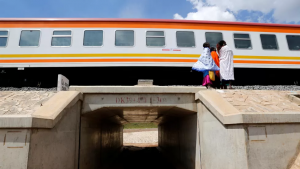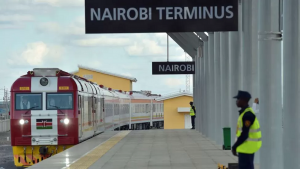China’s Belt and Road Initiative: Kenya and a railway to nowhere
The first section of Kenya’s Chinese-built railway was opened with much fanfare in 2017 – but two years later work on the tracks stopped in the middle of the country and the master plan of linking it to other landlocked countries in East Africa seems to have derailed.
This means the project is not bringing as much money as was hoped at this stage, while Kenya is left servicing loans totalling around $4.7bn (£3.9bn), mainly borrowed from Chinese banks.
Yet it is hard to believe that Kenya’s Standard Gauge Railway (SGR) is not a success when passengers disgorge from a packed train of around 12 carriages at the Syokimau railway terminus in the capital, Nairobi – the last service of the day.
They have travelled non-stop from the port city of Mombasa, 470km (290 miles) away on the Indian Ocean. “It’s great,” 53-year-old commuter Pauline Echesa told me. The four-and-a-half hour journey gives her the bonus of watching wildlife along the way as the railway cuts through national parks, she says.
A 30-year-old commuter found the experience a little more exhausting, saying the seats were not that comfortable but the journey saved her money compared to other ways of travelling from the coast.
There is no doubt the passenger side of the business is doing well and is fully booked, but it cannot pay back the loans on its own – and it was never meant to do so.
This burden falls to the cargo side of the business – bringing inland the containers that arrive at Mombasa port. It was intended that they would reach Uganda, Rwanda and the Democratic Republic of Congo.
The problem is that they can go only go as far as the Kenyan town of Naivasha – 120km from Nairobi but still far from the Ugandan border – on the SGR. Most of the freight trains then return to Mombasa empty, a huge loss of potential income.
“It will be more productive for us to continue with the project,” Kenya’s Transport Cabinet Secretary Kipchumba Murkomen told the BBC. “But the financing part is actually our challenge.” He says the government would be exploring options for funding the construction of the remaining portion of the railway during the upcoming Belt and Road Summit in China.
Launched in 2013, China’s massive Belt and Road Initiative (BRI) has stretched across the globe and noticeably changed the landscape of infrastructure across Africa. But its future is a matter of debate now as China continues to scale down funding and African countries face the reality of growing debt that in some cases threatens to destabilise their economies.
American think-tank the Council on Foreign Relations argues that some BRI investments have involved opaque bidding processes and required use of Chinese firms leading to inflated costs which have in some cases resulted in the cancellation of projects and a political backlash.
Internal issues that have affected the Chinese economy have also led to hugely diminished funding, says Nigeria’s former Deputy Central Bank Governor, Kingsley Moghalu. “The funding levels in the past couple of years have not been more than $2bn across the continent,” he says – down, he estimates, from between $10bn and $20bn a decade ago. Kenya’s SGR is one of those to have suffered.

Kenya is hoping to find backing to build the SGR line to the Ugandan border at the Belt and Road Summit in China (pic BBC)
But Mr Murkomen says Kenya is open to options: “We have private sector players in China who have said they are willing to put their own resources as long as we can have a conversation about how they’ll recoup their finances.” One could be a grace period to allow the country to first service the loans taken to finance the sections of the railway that are complete, he explains.
An admission that the government is seeking more funding may not sit well with many in the country who already reeling from tax hikes introduced by President William Ruto since he came into office a year ago.
Kenyans are concerned that debt repayments are exerting significant pressure on the country’s economy. Government figures from the end of June 2022 showed that China was Kenya’s third biggest external creditor – accounting for 19.4% of the country’s debt.
“Right now, the debt profile of the country is quite heavy,” says Kenyan economist Ken Gichinga, explaining that next June is when Kenya must repay a $2bn Eurobond. “And there is also a feeling that not all that money went to building the railway,” says Mr Gichinga.
The opacity in the deals countries like Kenya have signed with China is a matter of concern to their own citizens as well as critics abroad.
The Council on Foreign Relations assessment notes that loan terms are rarely made public and “because China refused to join the Paris Club of major official creditors”, Chinese banks are under no pressure to cap lending rates or share information.
This, it concludes, means the risks for both the US and recipient countries “considerably outweighed its benefits”.

Critics are concerned that the details of China’s loans are rarely publicly disclosed (pic BBC)
For Kenya’s railway to reap the benefits that were envisioned at its inception, it needs to go transnational. “Uganda really needs to also be onboard,” argues Mr Gichinga. But that ambition looks shaky.
The original East Africa Transport Master Plan, proposed by the East Africa Community around two decades ago, wanted two routes into landlocked countries from the coast – one coming from Kenya, known as the northern corridor, and another from Tanzania, dubbed the central corridor. It then had connections to South Sudan and DR Congo.
However Uganda may decide to push its business towards Tanzania. Its railway project has cost way less to build and offers higher speeds as the line is electrified.
Former Tanzanian President John Magufuli tore up the deal that had been signed by his predecessor with China to build the railway and chose to get funding instead from Turkey and Portugal to finance the first leg of the project.
Tanzania also appears on track to connect to Rwanda, Burundi and DR Congo – with China coming onboard in latter sections.
Mr Moghalu argues that, like Tanzania, countries on the continent “should be drivers of their own destiny”. “African countries need a mental repositioning and not feel like an abused spouse that they should be grateful to China because their former spouse, the West, did not treat them well.”
Western countries have recently been trying to counter BRI, including US President Joe Biden’s Build Back Better World Initiative, launched in 2021 in collaboration with G7 economies. But there is general acknowledgement that China still can offer more in terms of long-term development.
For the Nairobi-Mombasa commuters, such investments for the country’s future are definitely worthwhile. “Let us sacrifice to pay the debt and get more for such projects,” Ms Echesa told the BBC.
The Kenyan government will be hoping it can convince China, and its banks, that the SGR railway will be profitable if it gets to the border and beyond.
(BBC)



